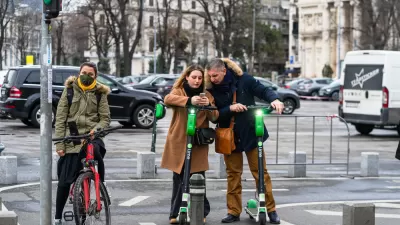A highly anticipated analysis of public health outcomes caused by the proliferation of electric scooters has been released. Most of the reported are considered preventable.

Sarah Holder reports that the Centers for Disease Control and Prevention (CDC) recently released a report on the public health threats posed by electric scooters, focusing on the preventability of many of the injuries suffered by scooter riders since they began hitting streets within the last year-plus.
Holder explains the circumstances that led to the study:
The CDC began studying the public health impacts of dockless electric scooters soon after the tiny contraptions arrived on the streets of Austin, Texas, in April of 2018. The city’s transportation and public health agencies quickly noticed that a lot of people seemed to be falling off the vehicles, so they requested support to study the problem. The CDC sent four researchers to help launch the first epidemiological investigation into the safety of the micromobility revolution. In the 87-day study period, the CDC and Austin’s Public Health agency identified 271 riders with potential e-scooter-accident-related injuries, and interviewed more than half of them.
According to the study's findings from Austin, 45 percent of the injuries suffered by scooter users were head injuries, and 15 percent of those were "traumatic head injuries."
"For every 100,000 trips taken, 20 individuals were injured," adds Holden to the findings shared and expounded upon in the article. Inexperience played a role in many of the injuries, as did road conditions. Interestingly, only 16 percent of the incidents counted in this study were involved cars or trucks.
FULL STORY: Scooters Wouldn’t Be So Dangerous If You Just Wore a Helmet

Alabama: Trump Terminates Settlements for Black Communities Harmed By Raw Sewage
Trump deemed the landmark civil rights agreement “illegal DEI and environmental justice policy.”

Planetizen Federal Action Tracker
A weekly monitor of how Trump’s orders and actions are impacting planners and planning in America.

Why Should We Subsidize Public Transportation?
Many public transit agencies face financial stress due to rising costs, declining fare revenue, and declining subsidies. Transit advocates must provide a strong business case for increasing public transit funding.

Judge Orders Release of Frozen IRA, IIJA Funding
The decision is a victory for environmental groups who charged that freezing funds for critical infrastructure and disaster response programs caused “real and irreparable harm” to communities.

‘Clybourne Park’ Sets Stage for Housing Equity Discussions
Clybourne Park, a play exploring race, real estate, and community tensions, can set the stage for discussion on the lasting impacts of housing discrimination, gentrification, and the fight for affordability.

Understanding Road Diets
An explainer from Momentum highlights the advantages of reducing vehicle lanes in favor of more bike, transit, and pedestrian infrastructure.
Urban Design for Planners 1: Software Tools
This six-course series explores essential urban design concepts using open source software and equips planners with the tools they need to participate fully in the urban design process.
Planning for Universal Design
Learn the tools for implementing Universal Design in planning regulations.
Caltrans
Smith Gee Studio
Institute for Housing and Urban Development Studies (IHS)
City of Grandview
Harvard GSD Executive Education
Toledo-Lucas County Plan Commissions
Salt Lake City
NYU Wagner Graduate School of Public Service





























